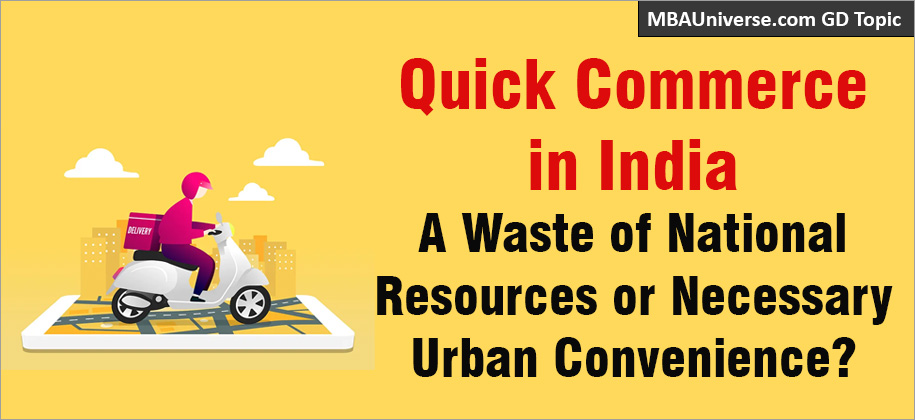
Group Discussion (GD) Topic is an important part of MBA Admissions process. Type of GD Topics include topics on Business & Economy, Current Affairs, Social and International Issues. Quick Commerce in India: Urban Necessity or Waste of Resources? is current important GD Topic that all MBA aspirants must prepare for. MBAUniverse.com presents facts and arguments for both sides. Also read 200+ Latest Group Discussion Topics with solutions for MBA admission.
Quick Commerce in India: An overview
Quick commerce (q-commerce) is reshaping urban retail in India by promising ultra-fast delivery services for groceries and other household goods often reaching customers in under 10-30 minutes. This business model, however, has invited debate about whether it truly serves the national economy or it squanders resources like people, fuel and infrastructure that can be used more effectively.
Quick Commerce in India: A New age Phenomenon
Quick commerce, often called Q-commerce, has rapidly emerged as a significant segment in India’s retailing landscape. This model promises ultra-fast deliveries, within 10 to 30 minutes, caters to the growing urban middleclass that requires instant gratification. Companies like Zepto, Blinkit (formerly Grofers) and Swiggy Instamart are at the forefront.
The impact of Quick Commerce in India could be felt in Diwali 2024. While in past streets were jammed with people busy with festival shopping, this year, according to retail traders, there was a significant fall in offline retail sales.
The quick commerce market in India is projected to triple by 2029, reaching an estimated $10.00 billion from $3.34 billion in 2024. This growth is driven by increasing consumer expectations for speed and convenience, especially in large cities like Delhi, Mumbai and Bangalore. Furthermore, this trend has attracted significant financial investment. Blinkit, Zepto and Swiggy Instamart have scaled their operations aggressively.
This consumer shift has flustered the large and established players. Shares in Avenue Supermarts, owner of Dmart, plunged by 10% in October 2024, in response to company statement on surge of quick-commerce competitors. Mukesh Ambani’s Reliance supermarket chain is also testing a pilot for sub-30-minute deliveries.
However, this sector faces many challenges including high operational costs and business viability due to low margins. Indeed, Quick Commerce in India has both pros and cons.
Let’s start with the positive side of quick commerce in India.
Quick Commerce: A Necessary Urban Convenience
Quick Commerce: A Waste of Resources
Let’s also review the negative side or cons of q-commerce in India.
Conclusion
As discussed in this GD Topic, Quick commerce is a complex mix of opportunities and challenges for India. While it provides convenience and job creation, it also risks promoting unsustainable consumption patterns and labour exploitation. Balancing the benefits will be key to ensuring the sector contributes meaningfully to national progress. As the industry evolves, all stakeholders including the regulators, companies, and consumers must work together to enhance its impact on India’s economy and environment.
Also Read:
Latest 2024 GD Topics
Exam 2024 Notification